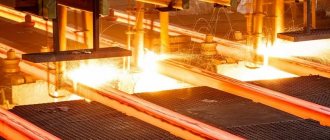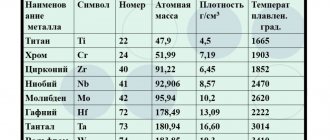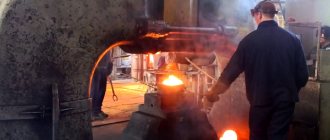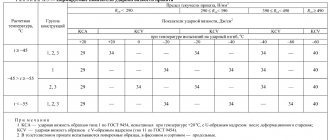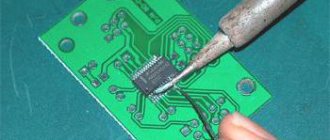Basic information
Heat-resistant metal materials of domestic production are produced in accordance with the technical requirements of GOST 5632-2014. Their composition is characterized by the following features:
- Higher carbon percentage.
- The obligatory presence of refractory metals - molybdenum, tungsten, cerium, titanium. There is also nickel, which protects the surface from high-temperature oxidation.
- The presence in bound forms of non-metals such as silicon and nitrogen.
- A fairly high percentage of aluminum, which is necessary for successful deoxidation.
Much less frequently, the chemical composition of heat-resistant alloys (mainly for special purposes) includes copper, cobalt and boron. Products from a foreign manufacturer must meet DIN 1.4541 standards.
When the described conditions are met, the materials retain their resistance (including corrosion resistance) and strength at elevated temperatures. The criteria for fatigue strength/creep resistance at high temperatures are very important. In contrast to conventional structural materials, increased attention is paid to stresses arising from high operating temperatures.
In foreign manufacturing practice, these conditions are united by the general concept of life cycle costs (LCC).
When determining the level of performance characteristics obtained after smelting, the following are also taken into account:
- Resistance to scale formation due to the creation of an oxide layer;
- Reduced fragility, which complicates subsequent machining;
- Independence of characteristics from heating conditions.
- The method of heating the surface of a part that is made of heat-resistant steel is not established.
Finnish sauna or Russian bath? Determining the heater
The type of heater determines the moisture temperature regime, which means you will have to choose what you like best: a classic Russian bath or a Finnish sauna.
Artemenko Vyacheslav Manager of the store on the street. Kollontai, 18
The Russian bath is characterized by high humidity (60%) at moderate air temperatures (60-65 degrees Celsius).
The Finnish sauna, on the contrary, is characterized by high air temperatures (90, 100 and above degrees Celsius) with minimal humidity (10-15%, less often 20%).
The principle of creating a temperature regime in a steam room due to the type of heater is quite simple. Let us remember physics: the hotter the surface on which water falls, the fewer moisture particles (fractions) are formed.
Open heater - stones lie “on top”. The stones are open to the eye, so they come into contact with air, and as a result they cool down. This heater creates a temperature regime close to a Finnish sauna. The temperature of the stones when water is supplied is within 200, maximum 250 degrees Celsius. When water hits the stones, it forms coarse-grained steam (like steam from a boiling kettle), tubers of smoke are formed, which make it difficult to breathe.
Closed heater - stones are hidden in a compartment. The stones are kept in a closed place - this is a special, usually metal, compartment in a sauna stove. Such stones are enveloped in fire from all sides and become very hot (400-450 degrees Celsius). When water is applied to such stones, finely dispersed steam is formed, which feels light and “soft”. This heater dries quickly and recovers.
Combined heater. The design of the stove is made in such a way that there is both a visible, open part, and a closed, inner part of the heater. In such models, the open part of the heater performs more of a decorative function. The main supply of water goes to the closed part, forming light, fine steam. If you wish, you can, of course, supply water to the open heater, but the steam, again, will be harsher. Note that the open heater in such models additionally plays the role of a convector that extinguishes infrared radiation.
Fig 2. Types of sauna stove heaters
Chemical composition
GOST 5632-2014 includes grades of not only heat-resistant alloys and steels, but also heat-resistant ones. The difference between them is that in the second case, resistance to high-temperature oxidation is of predominant importance, while the former must additionally have increased mechanical strength.
Chemical composition limitations, regardless of how they are prepared, include:
- Carbon,% - from 0.02 to 1.2.
- Manganese,% – from 0.5 to 10.
- Silicon,% - from 0.15 to 2.0.
- Chromium,% - from 10 to 30.
- Nickel,% - from 0.5 to 30.
The remaining chemical elements are added unsystematically, depending on the purpose of the product. The composition of certain chemical elements determines the structure of steel and the level of performance indicators.
Metallurgical impurities, the level of which depends on the method of obtaining the material, should be distinguished from permanent components. In this way, the actual percentage of tungsten, copper, aluminum, titanium, zirconium, and of non-metals - sulfur, nitrogen and phosphorus is established.
Some grades are smelted by individual metallurgical enterprises according to their own specifications, and therefore have individual markings and chemical composition. Thus, heat-resistant alloys with the initial letter D in the name refer to products that are produced (Ukraine), if the initial letter is E, then by the Elektrostal enterprise (Russia), etc. The same principle applies to products at the experimental development stage.
Grades of martensitic heat-resistant steel
The most popular brands:
- X5. Intended for pipes used at temperatures of 650 degrees. This brand is not designed for high temperatures.
- 1Х8ВФ. Used for the manufacture of steam turbine parts. Withstands temperatures of 500 degrees. Moreover, their service life is 10,000 hours.
- Several brands are combined into one group because they have similar characteristics: X5M, X5VF, 1 X8VF, X6SM, 1 X12N2VMF. Intended for elements manufactured for operation at temperatures from 500 to 600 degrees. The service life of the parts varies from 1000 hours to 10,000 hours.
- Two more brands are combined according to general indicators: 3Х13Н7С2, 4Х9С2. Valves of transport engines are made from them. Able to withstand temperatures from 850 to 950 degrees.
Stainless steel is a durable material that is resistant to corrosion and high temperatures Source 90zavod.ru
Martensitic steels contain pearlite. As the level of chromium in the alloy increases, it changes its state. Grades of steel containing pearlite and chromium:
- Х13Н7С2.
- X6SM.
- X6S.
- X10S2M.
- X7SM.
- X9S2.
The principle of producing martensitic steels is to combine the constituent elements and further harden them at a temperature of 1000 degrees. To increase the level of heat resistance, the alloy is tempered at a temperature of 8100 degrees. It is this procedure that allows the steel to withstand prolonged heating.
Structure and properties
Heat-resistant steels are used in a wide range of operating conditions, which include heat and corrosion under static and dynamic loads. A material used at elevated temperatures requires three important properties:
- Resistant to oxidation and scale formation.
- Maintains strength at operating temperature.
- Structural stability against carbide precipitation, spheroidization, formation of so-called sigma phases and temper embrittlement
In specific applications, other properties are also important. For example, in the manufacture of furnaces, special attention is paid to specific resistance indicators and values of the coefficient of thermal expansion and thermal diffusion of gases. In steels that are used for the production of gas turbine parts, it is also necessary to take into account additional characteristics such as;
- Internal damping capacity;
- Fatigue strength;
- Sensitivity to cuts;
- Impact strength (hot and cold);
- Welding ability.
Typically, the scale formed on iron is porous and loosely adjacent to the main surface, but it becomes denser when chromium, silicon and aluminum are added during smelting - these chemical elements are characterized by an increased affinity for combining with oxygen, and the passage of these reactions is quickly suppressed by the formation of inert oxide films.
Advantages of stainless steels
With the development of economic, scientific and technological progress, the requirements for the quality of materials used in areas of the national economy are growing.
Advantages of alloy metals:
- High level of anti-corrosion properties.
- Compliance with the standards stipulated by fire safety regulations.
- Reliability, long service life without changing technical characteristics.
- Ideal combination with any building materials.
- Variety of surfaces: polished, polished, matte, decorative.
- Wide selection of rolled metal products.
- Ease of processing, molding, and assembly of parts made from this type of steel.
- A wide range of brands with unique properties.
- Environmental safety, hygiene.
How is heat resistance achieved?
The resistance of low-carbon heat-resistant steels to high-temperature oxidation increases significantly if a surface film consisting of an alloy of aluminum and iron is formed on the surface. To do this, the material is heated to 1000°C in contact with powdered aluminum (calorification method) or aluminum is sprayed onto a steel surface (aluminizing method).
High temperature creep resistance can be achieved in two ways:
- Increasing the softening temperature with a solution of alloying elements;
- Using the dispersion hardening mode.
The precipitation hardening process occurs in two phases, with the second hardening phase critically depending on the degree and uniformity of the dispersion achieved, and the creep rate is related to the critical range of distances between particles. During precipitation hardening, it is extremely important to ensure a controlled degree of strain hardening in the appropriate temperature ranges.
The vacuum melting method is considered especially effective, in which:
- Deoxidizers and particles at crystal boundaries have a more noticeable effect on creep properties;
- It is possible to use combinations of elements that cannot be melted by conventional methods;
- The ductility of the ingot in the transverse direction is improved.
The role of various additive elements to heat-resistant steels or alloys:
- Cobalt, tungsten and molybdenum provide stabilization of the tempering process;
- The presence of silicon and chromium increases the Ac point;
- As the percentage of nickel increases, the high-temperature resistance decreases, especially if the part is in contact with gases containing sulfur dioxide or other sulfur compounds.
- In high-chromium steels, carbides coalesce into large particles that are less likely to inhibit ferrite grain growth at temperatures above 700° C. Excessive grain growth further reduces toughness.
These features determine the sequence of transitions in the smelting of the steels under consideration.
Food grade stainless steel
This type of rolled metal is ground and differs from other types in a special way of treating its surface. The final layer of food-grade material is sanded until shiny. This type of stainless steel is environmentally friendly and does not react with acids, alkalis, or detergents.
Popular brands and their applications:
- 08Х18Н10 – widely used for the production of food equipment.
- 08Х13 – metal suitable for making kitchenware and cutlery.
- 20Х13, 40Х13 are ideal materials for the production of sinks and containers in which thermal and hygienic processing of products is carried out. It is used to produce equipment intended for the production of wine, alcohol, and food.
- 08X17 is a popular material for cookware exposed to high temperatures.
The optimal amount of alloying elements included in the composition of stainless steel forms a protective film on the surface of the metal. The use of this type of steel is necessary for the production of products that are exposed to long-term exposure to water vapor, heating and boiling of liquid food products. Due to the properties of food grade steel, when cooking food, there is no chemical interaction between the products and the container in which they are located.
Classification of heat-resistant metals and alloys
It can be carried out according to the degree of saturation of the composition with alloying elements. Accordingly, heat-resistant/heat-resistant steels can be low-, medium- and high-alloy. However, the classification by microstructure is more meaningful, according to which the following classes of steel are distinguished:
- Austenitic;
- Austenitic-ferritic;
- Martensitic;
- Perlite;
- Ferritic;
- Martensitic-ferritic.
Some features of these types are discussed below.
Austenitic class
High-alloy austenitic steels are the most numerous group because they are the easiest to melt. They contain a significant percentage of chromium and nickel and do not harden when air cooled. At heating temperatures above 1000°C they are characterized by minimal grain growth. However, no production problems arise because the product remains durable and ductile even in the coarse-grained state.
When heated in the range of 500...900°C, austenitic steels release carbides along the austenite boundaries, as a result (with the constant presence of tensile stresses in this temperature range) intercrystalline cracks can develop. At certain compositions, austenitic steels can become brittle due to the formation of a sigma phase. Good weldability.
Austenitic-ferritic class
Such steels are often called duplex. Each grade is iron-based and alloyed with at least 10.5% chromium, which gives the metal high corrosion resistance.
Any duplex stainless alloy is a combination of austenite and ferrite, so it is characterized by mixed physical and mechanical characteristics of these two grades. The degree of alloying is medium. In the core market, the share of duplex steels is small and does not exceed 2...3%.
Martensitic class
The main feature of martensitic grades is their extremely high hardness and strength at room temperatures. Precipitation-hardening grades have good formability at room temperature and can reach (after heat treatment) a strength of 1800 MPa, while maintaining proper corrosion resistance.
Martensitic steels are used in the manufacture of highly loaded components and parts, but their smelting is difficult, since annealing is required after rolling.
The composition contains mainly chromium, and other alloying additives - nickel, chromium, molybdenum or vanadium - are available in very limited quantities.
Pearlite class
Pearlitic steels are characterized by a low degree of alloying and contain chromium, vanadium, tungsten and molybdenum. Heat resistance, in comparison with other brands, is minimal, so they are used for the production of products whose maximum operating temperature is 500...5500C. Strength at such temperatures is not regulated by domestic standards.
Ferritic class
Heat-resistant steels of the ferritic class are non-magnetic. They operate satisfactorily at operating temperatures up to 850...9500C. When this range is exceeded, the mechanical strength decreases noticeably.
Steels of this class are characterized by increased machinability, since they are ductile and have high impact strength, which is maintained at elevated temperatures.
The main alloying element is chromium; there is also a small amount of titanium, nickel and aluminum.
Martensitic-ferritic class
Along with martensite, they contain a certain amount of ferrite grains. In terms of heat resistance (up to 6000C) they occupy an intermediate position between steels of the martensitic and ferritic classes. Of the alloying additives in the chemical composition, up to 10...13% chromium is noted, the rest is iron, vanadium, tungsten, niobium, molybdenum and nickel.
Stove doors: if you want to admire the fire, consider the nuance
Everything is simple here. The door of a wood stove can be solid or glass. Of course, the glass door will allow you to enjoy the view of a live fire and at the same time control the availability of firewood in the stove. It is important to consider the following: if you have a stove without an extension, and the steam room is small, then the glass door can burn your feet with infrared radiation from the firebox of the stove. In this case, we recommend that you refuse this “bonus” and give preference to solid doors.
By the way, there is a story that through a glass door it will be possible to partially heat the room into which it opens. It is a myth. Of course, the door will transfer heat into the room, but it is so insignificant that it can be ignored.
Areas of application
Heat-resistant metal is widely in demand for the manufacture of industrial equipment in the following industries:
- Ceramic industry;
- Glass industry;
- Chemical and petrochemical industry;
- Food industry;
- Boiler making and energy;
- Instrumentation;
- Pulp and paper production.
Typical parts are heat treatment furnaces, high-power heat exchangers, automobile exhaust systems, etc.
Polished stainless steel
This type of stainless steel is a material with an absolutely smooth surface and a high reflective effect. The technological process of its production differs from other types of stainless steel in the method of surface treatment. It is carried out on special equipment using control and measuring instruments.
Stages of grinding sheet metal.
- Processing with abrasive materials using a special tape.
- Sanding with fine-grained sandpaper or brushes.
- Finish with grinding wheels to a mirror finish.
Areas of application of polished stainless steel:
- Sanded pipes are used to transport oil, gas, liquid foods and alcohol.
- Polished metal products are in demand among designers. It allows you to create creative architectural projects.
- The material is widely used for the manufacture of household appliances, medical equipment and tools, and devices for the food industry.
Polished alloy metals are used in all areas of the national economy where an absolutely smooth and durable material that meets environmental safety standards is required.
Welding features
Modern welding methods make it possible to obtain strong welds that are resistant to the formation of hot cracks on parts made of heat-resistant stainless steels. However, alloys of this type are prone to softening and fracture of the cold weld. To eliminate the disadvantage, general or local heating of the material is carried out in order to minimize the temperature difference at the periphery and at the welding points to reduce stress. After welding, the finished products are tempered for several hours at temperatures up to 2000 °C. As a result of tempering, the main part of the hydrogen dissolved in the structure is removed, and the residual austenite is transformed into martensite.
- Content:
- Which brand of steel is best for a sauna stove?
- Optimal metal thickness for a bathhouse stove
- What electrodes should be used to cook a sauna stove?
Homemade sauna stoves cost on average 3-5 times cheaper than factory products. The savings will be even greater if you do the welding yourself. When making it yourself, you will need to decide on the following:
- What metal to make a sauna stove from?
- What metal thickness will be optimal?
- What type of electrodes should be used to ensure maximum weld strength.
The speed of heating of the steam room, the duration and intensity of operation of a self-made stove depend on the answer to all these questions.
Provider
Are you interested in the processing and production of heat-resistant steel and alloys? The processing and production of heat-resistant steel and alloys from the supplier "Auremo" complies with GOST and international quality standards, the price is optimal. The supplier "Auremo" offers to buy heat-resistant steel and alloys on favorable terms. For wholesale customers the price is preferential. Large selection in stock. Heat-resistant steel and alloys are always available, the price is optimal from the supplier. We are waiting for your orders.
Buy, favorable price
The supplier "Auremo" offers to buy heat-resistant steel and alloys on favorable terms, the price is determined by the technological features of production without including additional costs. The company's website displays the latest information. You can order products with non-standard parameters. The order price depends on the volume and additional delivery conditions. The supplier "Auremo" invites you to buy heat-resistant steel and alloys in bulk or in installments. We have the best price-quality ratio for the entire range of products. It is a profitable supplier in this segment.
Notes
^ 1 2
Aviation.
Encyclopedia. M.: Great Russian Encyclopedia, 1994, p. 201 Luft.-Forschung, Bd 18(1941), N 8, S. 275—279 Pomp A., Krisch A.: Zur Frage der Dauerstandfestigkeit warmfester Staehle bei 600, 700 und 800 °C. Mitteilungen der KWI fuer Eisenforschung (Abhandl. 400), 1940 Report on Visit to Germany and Austria to investigate Alloys for Use at High Temperature. BIOS Final Report N 396, London, 1946 ^ 1 2
Giamei AF, Pearson DD, Anton DL Materials Research Society Symposium Proc.
1985, v. 39, pp. 293-307, , P. Aviation materials science. — in the book: Development of aviation science and technology in the USSR. Historical and technical essays. M.: Nauka, 1980, p. 332—334 https://www. msm. cam. ac. uk/phase-trans/2003/nickel. html - www. msm. cam. ac. uk/phase-trans/2003/nickel. html ^ 1 2 3 4
Superalloys - www. msm. cam. ac. uk/phase-trans/2003/nickel. html
